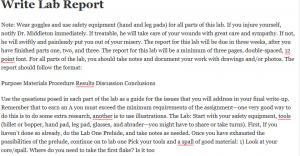Write Lab Report

Note: Wear goggles and use safety equipment (hand and leg pads) for all parts of this lab. If you injure yourself, notify Dr. Middleton immediately. If treatable, he will take care of your wounds with great care and sympathy. If not, he will swiftly and painlessly put you out of your misery. The report for this lab will be due in three weeks, after you have finished parts one, two, and three. The report for this lab will be a minimum of three pages, double-spaced, 12 point font. For all parts of the lab, you should take notes and document your work with drawings and/or photos. The report should follow the format:
Purpose Materials Procedure Results Discussion Conclusions
Use the questions posed in each part of the lab as a guide for the issues that you will address in your final write-up. Remember that to earn an A you must exceed the minimum requirements of the assignment—one very good way to do this is to do some extra research, another is to use illustrations. The Lab: Start with your safety equipment, tools (billet or bopper, hand pad, leg pad, glasses, and abrader—you might have to share or take turns). First, If you haven’t done so already, do the Lab One Prelude, and take notes as needed. Once you have exhausted the possibilities of the prelude, continue on to lab one Pick your tools and a spall of good material: 1) Look at your core/spall. Where do you need to take the first flake? Is it too
thick? Is it concave in one area? Does it have unsightly lumps on its surface? What do you need to do to turn this unforgiving piece of rock into a chipped stone tool?
2) Amongst the many challenges you encounter, pick the most important for
getting the job done. That will be your first flake. It is a good idea to mark on the spall what you want to take off and where you want to hit it.
3) Prepare a “striking platform.” Use your hammer stone or an abrader to
prepare your surface. Abrade the surface in the opposite direction that plan to take the flake. The platform should be at a 90 degree angle to the direction that you plan to take the blow.
4) Strike the flake. Don’t be afraid to hit it hard. 5) Collect the flake. Look it over. What does it tell you about how well you did
with your first attempt? 6) Ok, did it turn out like you thought it would? What went right, what went
wrong? Why do you think things turned out as they did?
7) Repeat parts one through four. As often as necessary. You want to turn your
piece of rock into a tool. Continue collecting your flakes. 8) So you have a tool. Or not. What has your experience taught you about the
process of producing a stone tool? Think about these questions: In your report (due in three weeks), describe what you were trying to do and why you were trying to do it. Talk about your materials, and how you went about your task. Describe your results, what happened, and whether or not things turned out as you planned. Discuss your results; why did things turn out as they did? How could things have turned out differently? In addition to the basic report, also think about these questions:
• What does a person think about when they start thinking about making a stone tool?
• What do you have to do when you go out from your house and want to
make a stone tool?
• What is the trade off between picking out the perfect raw material and finding what is available?
• Is the debris you produce recognizable as debris from stone tool
production, or is it pretty much just broken rocks?
• How big an “archaeological footprint” do you think stone tool manufacture leaves in the archaeological record? How easy do you think it is to recognize stone tool manufacture?
• What do you think is the most difficult part of making a stone tool?
• It is a good idea to collect debitage, draw the debitage and your tool in
progress, and/or photograph your work at each stage. That all counts as exceeding the minimum requirements.
Finally, start thinking about what kind of stone tool you actually plan to make for Lab One, Part Three. This is part one. The report on parts one, two, and three of this lab will be due, in class, on your lab day of week Six, either 4 or 6 October.